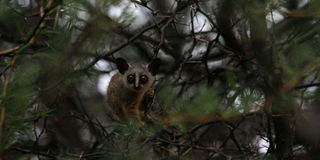When Bush baby taught me the value of good poultry house

Bush babies are tiny, nocturnal and extremely swift animals found throughout East Africa. Most often, they live in tree hollows. Sometimes they construct nests in the forks of branches. They prefer living on trees with little grass around them, probably as a precaution against wildfires. They also seek shelter in man-made beehives. PHOTO | FILE
What you need to know:
- Having identified the thief, I travelled to the farm and put up garden lights in the area the coop was and asked Jesse to be sleeping in a house adjacent to the coop.
- This ordeal taught me to consider predators when constructing my chicken coops. An ideal chicken coop should provide the birds with a comfortable environment and protect them from extreme weather (rain, wind and direct sunshine) conditions and predators because diseases are not the only risk to the birds. Having a dog in the compound can also help.
Exactly 35 days ago, I received a call from Jesse, the helper on my chicken farm in western Kenya.
I was in a meeting and his insistent calls informed me something ominous had happened. I excused myself, went out of the room and called him.
“They are gone; 15 of them. I woke up and found the chicken dead in the run,” he said as he panted.
I asked Jesse a few questions including if the door was left open and whether he had sighted a wild dog or cat in the compound. He answered in the negative.
I told him I would call later. Unfortunately, my busy schedule did not allow me to. Besides, I normally don’t take immediate action.
The following day, Jesse was on the line again, at about 6.30am. Fifteen chickens had been mauled again, with him finding some in the nearby bush.
You see, I had I transferred 104 chicks sometime in July to my rural poultry farm due to limited space in the city, where I keep over 1,000 birds. At the time, the chicks were four weeks old and very healthy.
I had already administered the first and second Gumboro vaccines on Day 10 and 18. I had also given the first New Castle Disease (NCD) vaccine at week three.
I had further offered fowl pox, the second NCD and fowl typhoid vaccines at week six, seven and eight.
IDEAL COOP
My workers, Wilson and Jesse, did a fantastic job caring for the chicks as none died, until the mauling began.
Strange enough, in the saga, there were no signs of a break-in. The lower part of the coop was made of mud and cement and the upper wire mesh.
I had to take action. I asked Jesse and Wilson to add kuku net over the wire mesh.
But as fate would have it, the killing did not stop. I lost another eight birds bringing my total losses to about Sh23,000 if I was to sell each bird at Sh600.
Battered, I inquired from neighbours if they had experienced a similar problem. They had not, but one informed me he had seen a small animal with big-round brown eyes and pointed ears climbing on his banana stems.
“This must be a Bush baby,” I thought. Bush babies are tiny, nocturnal and extremely swift animals found throughout East Africa. Most often, they live in tree hollows. Sometimes they construct nests in the forks of branches. They prefer living on trees with little grass around them, probably as a precaution against wildfires.
They also seek shelter in man-made beehives. From my research, I found out that they fear light.
Having identified the thief, I travelled to the farm and put up garden lights in the area the coop was and asked Jesse to be sleeping in a house adjacent to the coop.
So far, this has solved the mystery deaths and I am praying hard that the killer would not return.
This ordeal taught me to consider predators when constructing my chicken coops. An ideal chicken coop should provide the birds with a comfortable environment and protect them from extreme weather (rain, wind and direct sunshine) conditions and predators because diseases are not the only risk to the birds. Having a dog in the compound can also help.
The chicken coop I have now constructed from wood and iron sheets is raised about a metre from the ground and has huge inverted metal flaps to prevent animals like cats, mongoose, Bush babies and dogs from climbing on the poles. Always know the predators that are common in your area before constructing a coop.
To ensure your chickens are comfortable, have a 30x30cm (90 square cm) per bird floor area. A coop measuring 90x90cm, thus, houses a maximum of nine chickens. This measurement should not include nest boxes that each serves four hens.





